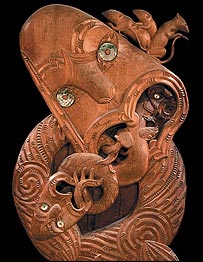The Polynesian migration pattern from Asia into Oceania was not as simple and fast as people tend to think * This knowledge was produced from a genetic comparison between rats in different areas of Oceania and its surroundings

Scientists have used rat DNA measurements to trace the migration patterns of the ancestors of today's Polynesians. It is estimated that people arrived in Polynesia - an area that includes the islands of Fiji, Tonga and Samoa in the Pacific Ocean by boat about 3,000 years ago.
From the data of the rats, the researchers hypothesize that the journey was much more complex than the "express train" theory holds, according to which there was a rapid dispersal of humans who arrived from South Asia. The details appear in the collection of articles of the National Academy of Sciences (Proceedings of the National Academy of Sciences).
Elizabeth Mattiso-Smith and Judith Robbins from the University of Auckland, New Zealand, analyzed a variety of DNA samples from Pacific rats (Rattus exulans). The genetic material was removed from the cellular structure known as mitochondria and not from the cell nuclei. Mitochondrial DNA changes at a constant rate over time, so scientists can use this fact to track changes in the rat population over time.
Rats on a ship
The researchers found clear geographic patterns of the rats' DNA across Oceania. The rats appeared in the area known as Oceania, which includes New Guinea, the Solomon Islands and Bougainville, about 3,500 years ago.
They appear to have hitched a ride on ships used by ancient seafarers known as the Lapita, a people Rivam researchers consider the ancestors of modern Polynesians.
The mitochondrial DNA of the rats were divided into three types. One type is found mainly in Southeast Asia. Type 2 is found in Southeast Asia and in the area near Oceania. Type 3 is found only in the remote areas of Oceania including the islands of Vanuatu, Fiji and Samoa.
The researchers claim that the results allow them to reject two famous theories about the colonization of Polynesia, including the high-speed train to Polynesia (ETP) and the theory of settlement by the natives of the Bismarck Islands ((BAII.
These two theories are opposite sides of the spectrum. The high speed train theory focuses on the rapid dispersal from Taiwan to Polynesia. The second theory suggests that there was no migration into the area near Oceania, and that the Lapita culture appeared among the natives of the area.
Mattiso-Smith and Robbins argue that the truth lies somewhere in the middle. The absence of type 3 rats in the area near Oceania excludes the possibility of constant spread from this area to the remote areas of Oceania, where the third type is common.
Instead, the researchers claim, the seafarers who brought the rats of the third type to the remote areas of Oceania did not come from New Guinea or the nearby Solomon Islands, but rather from a place closer to the Asian continent itself, bypassing the area next to Oceania.
